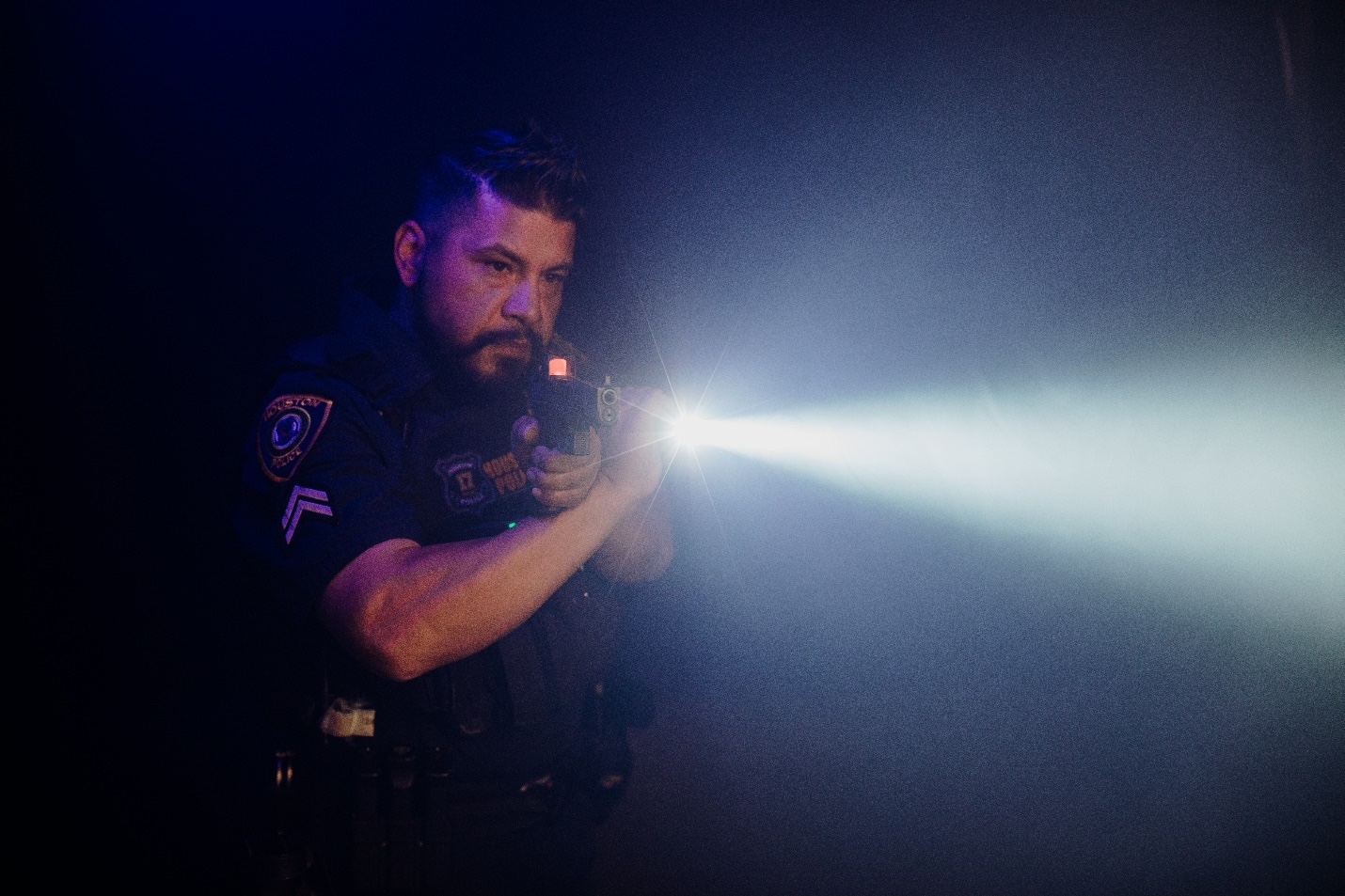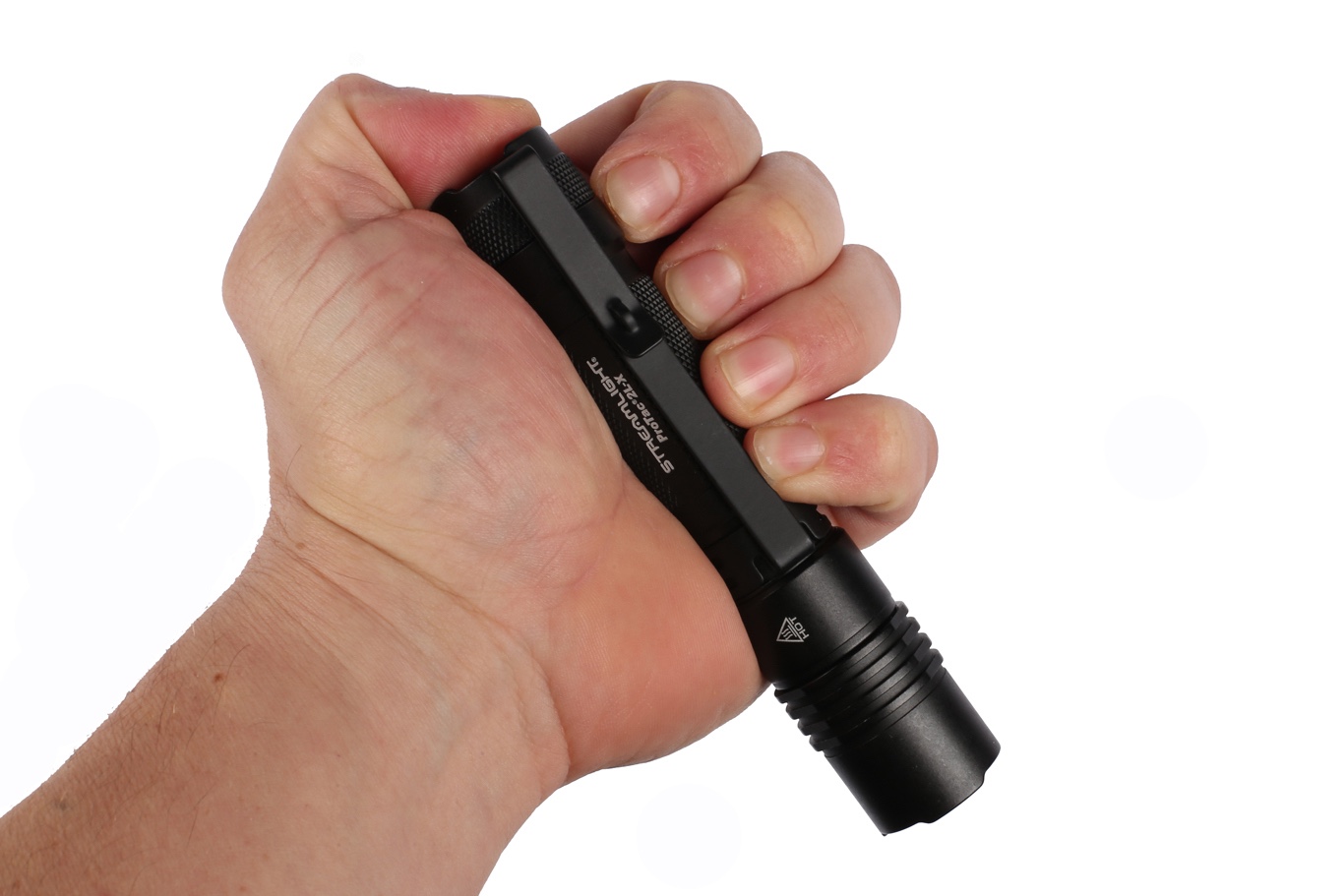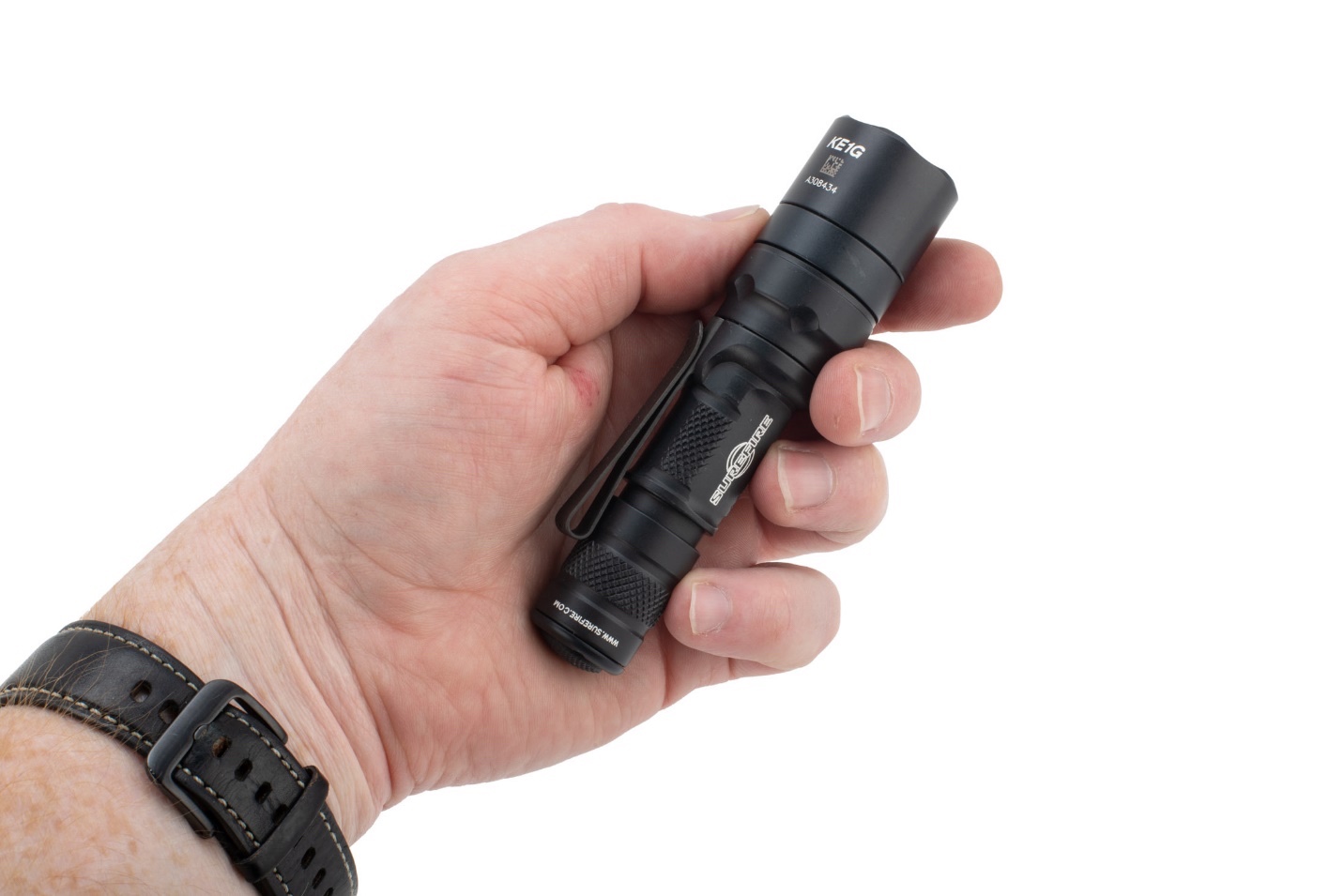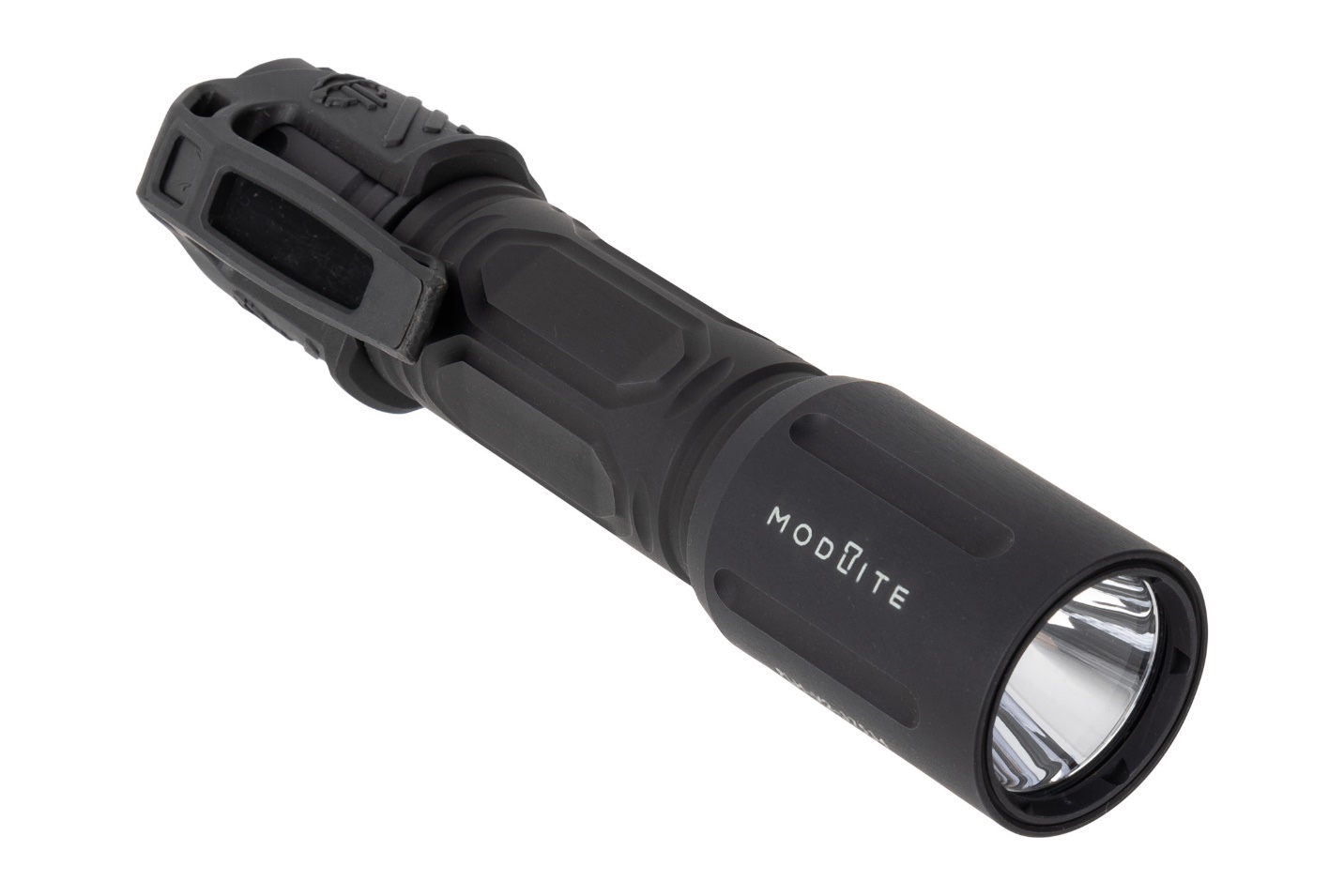
“Tactical” is a word that gets thrown around a lot these days, used for everything from pens to bacon. In this context though, we mean a light that’s designed specifically for use in high-stress situations and demanding environments, both with and without a firearm.
First and foremost, it needs to produce enough light. There’s a great deal of debate about what constitutes “enough” light, but we can comfortably say a tactical light needs to output at least 300 lumens on its highest setting.
Next, we want to consider the secondary attributes of the beam. The most common metric for this is candela. While lumens measure the total amount of light a flashlight creates, candela measures how much of that light is focused in a single direction. A higher candela means a more focused beam with higher intensity. A light with very high lumens but very low candela is basically going to be a lantern rather than a spotlight.
Candela often gets simplified into “flood” and “throw.” Flood describes a flashlight’s ability to light up a wide area, while throw speaks to how well it can illuminate objects far away.
In a good handheld tactical flashlight, we want a combination of the two. Good flood is important, because you may not know exactly where the suspected threat is, but you also want your light to be able to illuminate objects and figures from a good distance.
After a good beam, we want to look at the control scheme. A tactical flashlight needs to be usable with a pistol, so one-handed operation is important. A push-button tail switch is usually best.
Most firearm/flashlight techniques are designed around flashlights with tail switches, so low-light training will be easier if you’re starting with a tail switch light. There are a few exceptions, though, so a switch located somewhere on the body is not necessarily a deal-breaker if it’s well designed.
Regardless of the activation system, a tactical flashlight must be capable of going straight to high output with a single button press. There’s no time for cycling through modes when you’re trying to decide if a shadow in the darkness is a threat or not.
Other tactical features like crenelated bezels or shielded switches are nice to have, but largely unnecessary. A crenelated bezel can improve the flashlight’s performance as an impact weapon or glass breaker, but that’s not the primary purpose of a tactical flashlight.
Shielded switches, especially tail switches, are convenient in that they make the flashlight less likely to activate unintentionally. Shielded tail caps can make a light easier to balance pointed straight up, which is nice if you need room-wide light for an extended period, such as during a power outage. But again, that’s not the primary purpose of a tactical light, so we file that under convenient rather than necessary.
With all that in mind, let’s look at a few of the most popular tactical lights on the market.
Streamlight ProTac 2L-X

The Streamlight ProTac 2L-X won’t break the bank, but it’s a great example of all the features we look for in a tactical flashlight. It has a full aluminum body and can put out up to 500 lumens with 6,800 max candela. That’s a fairly low candela number for a tactical flashlight, so the ProTac 2L-X is going to have a lot of flood, perfect for an urban or suburban environment. If you want to be able to use your tactical flashlight to light up pastures, though, you may want to opt for one with more throw.
The switch is programmable with several different modes but comes from the factory in a high/strobe/low configuration.
This is good for tactical use, as it allows you to get straight to high output, but users would be wise to practice with it a bit. It’s easy to mash the button too hard and get constant-on when you wanted momentary, especially when you’re swimming in adrenaline.
It’s a multi-fuel light, so you can use your choice of disposable CR123A batteries or a rechargeable 18650. The bezel is lightly crenelated—enough to protect the light and make it effective as an impact weapon or maybe even as a glass breaker, but so much as to chew through your pocket. The tail switch is shielded to help discourage accidental discharge, but not quite enough to allow it to tail stand effectively.
At over five inches long, it’s what we would consider “full-size” for this kind of flashlight: anything larger wouldn’t really fit in a standard pocket and would be more at home on a belt. As such, it’s small enough for everyday carry, but most users are going to notice the extra weight and bulk in their pocket.
SureFire EDCL1-T

For a more pocket-friendly light, we recommend looking at the SureFire EDCL1-T.
The EDCL1-T offers many of the same features of full-size tactical lights, just in a smaller package. It outputs 500 lumens at high and an unobtrusive 5 lumens on its low setting. At 7,600 candela, it’s mostly focused on flood rather than throw, but with 500 lumens it will still reach out far enough for most applications.
It’s also got low-profile crenelation around the bezel but doesn’t feature any significant tail switch shrouding and won’t be able to stand upright on its tail. Not that this is a big deal; it’s a purpose-driven tactical light.
This is most evident in its switch design, which is very well thought-out. A light press activates the low setting, outputting 5 lumens, while a hard press gives you the full 500. This is perfect for high-stress use; just mash the button and see what’s out there. Both options are momentary, so there’s no chance of accidentally hitting constant-on.
Constant-on with this light is achieved by activating the desired mode and then twisting the bezel.
Sadly, the EDCL1-T is not compatible with rechargeable 18350 batteries; it runs on a single CR123A, with no dual-fuel function.
Modlite Systems PLHv2

The Modlite PLHv2 is the most powerful light on our list, kicking out a whopping 1350 lumens: no low mode, no high mode. The beam is potent as well, packing 54,000 candela.
The Modlite is deceptively simple in design; it looks basic, with no crenelations around the head or tail. The tail switch is fully shrouded though, recessed into the body of the light to prevent accidental activation. This full recess also allows the light to stand on the tail cap. The clicky tail switch works similarly to many of the others, offering momentary activation with a light press or constant-on with a full press.
To achieve its prodigious output level, the PLHv2 runs exclusively on 18650 or 18350 rechargeable batteries, depending on the body size you choose. It does not accept CR123A batteries at all; in fact, Modlite states that CR123 lithium batteries can explode if used in Modlite flashlights. Modlite does, however, offer a bundle with the handheld light and an appropriate 18650/18350 battery and charger, so you have nothing to worry about.
Lastly, because of Modlite’s design, popularity, and range of models, their flashlights enjoy a wider range of aftermarket accessories than most on this list. Heads, switches, pocket clips, retention rings; if they make it for a handheld flashlight, they make it for a Modlite. This gives Modlite a much higher range of available customization than the other lights.
The (Tactical) Light at the End of the Tunnel
There you have it: three tactical flashlights for your consideration, from budget to bespoke. Each has its own pros and cons and serves a particular use case. Like handguns, pocket knives, and most other tools, some will serve your individual needs better than others, but the most important thing is to have one on you when you need it.
Whether it’s telling if that thing rummaging through your garbage is a rabid raccoon or the neighbor’s cat, or identifying a figure lurking in an alleyway, a tactical flashlight gives you options a weapon light simply can’t.


Not diecussed in the three above, can add them here for educational comparisons.:
Both rechargeable, battery and charger included with each light.
Cloud Defensive MCH / EDC:
18650 Single Output option with 40,000 Candela @ 1400 Lumens
18650 Dual Output option: 4,000 Candela @ 140 Lumens in low mode and 40,000 Candela @ 1400 Lumens in high mode
Cloud Defensive MCH / HC
18650 Single Output option: 71,000 Candela @ 100 Lumens
18650 Dual Output option: 7,000 Candela @ 110 Lumens in low mode and 71,000 Candela @ 100 lumens in high mode
Cloud will be my next flashlight, for some of the reason you posted above. But also because they canceled a group order for the ATF. Based.
Matt – the MCH/HC figures are as follows (looks like you dropped a digit from the lumen output)
18650 Single Output option: 71,000 Candela/1100 Lumens/150 minutes
18650 Dual Output option: 7,000 Candela/110 Lumens (LOW), 71,000 Candela/1100 Lumens/150 minutes (HIGH)
Momentary switch with single output is tactical, 32 options to cycle through is strategic.
Interested in Cloud Defensive for some time. They up to snuff? I’m a simple civie but their OWL seemed well thought out…
Would be nice to know the credentials of these anonymous guest posters.